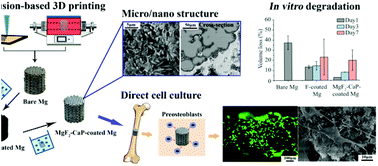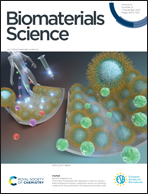Extrusion-based 3D printed magnesium scaffolds with multifunctional MgF2 and MgF2–CaP coatings†
Abstract
Additively manufactured (AM) biodegradable magnesium (Mg) scaffolds with precisely controlled and fully interconnected porous structures offer unprecedented potential as temporary bone substitutes and for bone regeneration in critical-sized bone defects. However, current attempts to apply AM techniques, mainly powder bed fusion AM, for the preparation of Mg scaffolds, have encountered some crucial difficulties related to safety in AM operations and severe oxidation during AM processes. To avoid these difficulties, extrusion-based 3D printing has been recently developed to prepare porous Mg scaffolds with highly interconnected structures. However, limited bioactivity and a too high rate of biodegradation remain the major challenges that need to be addressed. Here, we present a new generation of extrusion-based 3D printed porous Mg scaffolds that are coated with MgF2 and MgF2–CaP to improve their corrosion resistance and biocompatibility, thereby bringing the AM scaffolds closer to meeting the clinical requirements for bone substitutes. The mechanical properties, in vitro biodegradation behavior, electrochemical response, and biocompatibility of the 3D printed Mg scaffolds with a macroporosity of 55% and a strut density of 92% were evaluated. Furthermore, comparisons were made between the bare scaffolds and the scaffolds with coatings. The coating not only covered the struts but also infiltrated the struts through micropores, resulting in decreases in both macro- and micro-porosity. The bare Mg scaffolds exhibited poor corrosion resistance due to the highly interconnected porous structure, while the MgF2–CaP coatings remarkably improved the corrosion resistance, lowering the biodegradation rate of the scaffolds down to 0.2 mm y−1. The compressive mechanical properties of the bare and coated Mg scaffolds before and during in vitro immersion tests for up to 7 days were both in the range of the values reported for the trabecular bone. Moreover, direct culture of MC3T3-E1 preosteoblasts on the coated Mg scaffolds confirmed their good biocompatibility. Overall, this study clearly demonstrated the great potential of MgF2–CaP coated porous Mg prepared by extrusion-based 3D printing for further development as a bone substitute.



 Please wait while we load your content...
Please wait while we load your content...